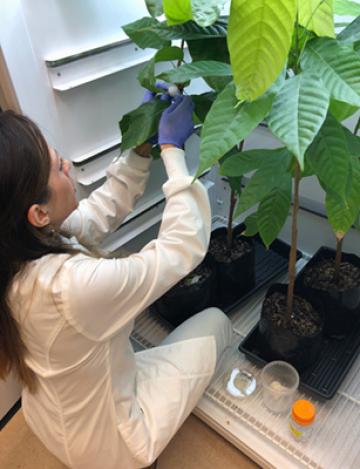For The Sake Of Chocolate: ARS Continues Its Labor Of Love In Cacao Plant Research

ARS plant pathologist Alina Puig determines pathogen virulence by infecting Theobroma cacao seedlings. (Wilber Quintanilla, D4881-1)
There are a few chocolate-centric holidays on the calendar, but none where it’s more traditional than Valentine’s Day. Your fancy may lie with dark, milk, or white chocolate; perhaps a ganache or chocolate covered nut (or insect) will do the trick this year. Whatever your pleasure, chocolate candies are also a major market for U.S. agricultural commodities such as peanuts, almonds, milk, and sugar.
Last year, the National Confectioners Association reported that the chocolate industry saw a rise in chocolate consumption, with $36.9 billion in 2021 U.S. confectionary sales. In light of this increasing demand for chocolate, many producers fear that increasing plant disease damage to the Theobroma cacao plant (the plant whose “cacao bean” seeds are really the source of chocolate) may reduce production to such an extent that there will not be enough chocolate to meet consumer demand.
The cacao plant has been threatened by numerous diseases caused by fungal, viral, and other pathogens that lead to the production of fewer pods or even death of infected plants. In the past few years, cacao mild mosaic virus (CaMMV) has been detected in the United States, Brazil, England, and Indonesia, and is considered an emerging disease on Theobroma cacao. Current ARS research is helping to ensure that there are enough cacao plants for chocolate by developing tools to identify and prevent the transmission of emerging cacao plant diseases like CaMMV.
“Diseases such as CaMMV are not harmful to humans, but they can cause plants to produce fewer, or smaller, pods,” said ARS researcher Alina Puig of the Foreign Disease & Weed Science Research Unit in Frederick, MD. “The virus is not believed to affect the cacao pod’s flavor, but it can cause a mosaic pattern on infected pods that leads to the production of abnormally small pods, as well as the loss of entire branches.”
This means that the taste of our beloved chocolate is safe. However, it also means that if CaMMV continues to be an agricultural challenge, the cost of chocolate may increase or there simply may be less available. Preventing spread of the pathogen is the most effective way to combat this disease as there is no cure for Theobroma cacao plants infected with CaMMV.
Scientists needed to find another way to determine if plants are infected by the virus, because symptoms of CaMMV infection are not always visible to the naked eye. Dr. Puig worked with ARS researchers in Miami, FL, and the University of Arizona to develop a DNA test that can detect the CaMMV virus and stop infected plants from being transported to other areas. Once the DNA test detects the virus, infected plants are removed and quarantined, and often used for further research.
Research currently shows that CaMMV is transmitted through graft propagation and mealybug insects. Prior to 2021, it was not known if the virus also could be transmitted through seeds, so seed-grown plants were not routinely screened for CaMMV infection. Since that time, research found CaMMV can be transmitted through seeds. ARS scientists are now investigating the rate of transmission and if seeds are a major pathway for disease spread.
Dr. Puig is working collaboratively with ARS research teams in Miami; Hilo, HI; Beltsville, MD; and within her ARS location in Frederick to continue CaMMV research. ARS researchers will also continue to develop CaMMV detection tools and investigate how plants become infected. – by Autumn Canaday, ARS Office of Communications

